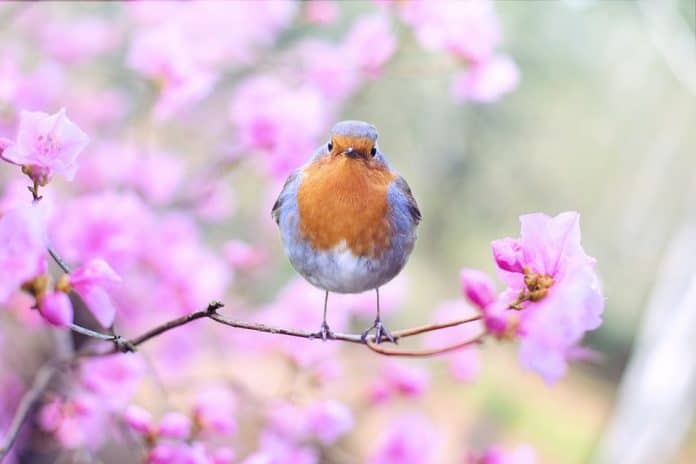by Jay Watson, Co-Executive Director, New Jersey Conservation Foundation
“Behold, my friends, the spring is come; the earth has gladly received the embraces of the sun, and we shall soon see the results of their love!” – Sitting Bull
Now that days are longer and temperatures are warming, many nature lovers share Sitting Bull’s joy. It’s time to get outdoors and enjoy this marvelous season of new beginnings!
What is nature doing in New Jersey right now? It’s bursting into life, as migratory species return, hibernating species reawaken, buds swell on tree branches, and new plants emerge from the ground.
Each region of this state we’re in has its own ecological schedule – with southern New Jersey being a week or two ahead of the northern counties – but the sights, sounds and smells of spring can be discovered everywhere.
Frogs, salamanders and vernal pools
“Vernal” means of or pertaining to spring, and vernal ponds – also known as intermittent pools – are bodies of water that exist mainly during the spring. Because they dry up during summer, fish don’t live there. This makes vernal pools an important breeding habitat for amphibians like frogs and salamanders, whose survival odds are greatly improved by not having fish to gobble up their eggs and young.
Many of New Jersey’s native amphibians hibernate in forested uplands during the winter, and in the spring, they migrate to vernal pools to breed and lay eggs.
Seven New Jersey amphibians – Eastern tiger, blue-spotted, marbled, Jefferson and spotted salamanders, and wood frogs and Eastern spadefoot toads – are known as “obligate” species because they are entirely reliant on vernal pools.
Another 16 amphibians breed in vernal pools but can sometimes reproduce in ponds with fish. These species include Southern gray tree frogs, Pine Barrens tree frogs, long-tailed salamanders, carpenter frogs, Fowler’s toads, Northern gray tree frogs, Northern spring peepers, and four-toed salamanders.
If there’s a vernal pond or wetland in your vicinity, you could be treated to a “chorus” of frogs singing to attract mates.
One iconic chorus frog is the spring peeper, a tiny woodland frog. Peepers are known for the males’ mating call — a high-pitched peeping or whistling sound repeated rapidly. The faster and louder the males sing, the better their chances of having a female choose them as a mate.
Spring ephemerals
Take a walk in the woods during the coming weeks and look carefully at the forest floor. There in the dappled sunlight, popping up through last year’s leaves, you may spot “spring ephemerals,” the short-lived blossoms of native perennials.
Spring ephemerals are native woodland wildflowers that bloom during the brief period between the start of spring and tree leaf-out. As the sun warms the ground, these little plants grow quickly, flower, are pollinated and set seed.
The season is just beginning for native ephemerals, including bloodroots, rue anemones, Eastern red columbines, Jack-in-the-pulpits, yellow marsh marigolds (cowslips), violets, wild geraniums, trilliums, flowering wintergreens, mayapples (wild mandrakes), Solomon’s seals, and moccasin flowers (pink lady’s slippers).
Many spring ephemerals are small and delicate compared to summer’s showy flowers, but well worth looking for. Spring beauty blossoms, for instance, are not much larger than a fingernail and have lovely pink stripes on a pale background.
Trout lily flowers are golden yellow bells speckled with spots, much like the fish for which they’re named. If you walk along a river or stream, you may see colonies of Virginia bluebells, whose magenta flower buds open into tubular blossoms of an exquisite sky blue.
Enjoy spring ephemerals while they’re here! By June, when forest floors are deeply shaded by a leafy tree canopy, the blossoms will be gone.
Migrating birds
This spring, keep your eyes peeled for the return of migrating birds. There are about 150 songbird species in New Jersey, and about half are “neotropical migrants” that breed in temperate areas of the U.S. and Canada and migrate long distances. Some winter in tropical areas of Mexico and Central and South America, and some travel even further south.
Neotropical migrants include wood thrushes, scarlet tanagers, cerulean warblers, brown thrashers, ruby-throated hummingbirds, bobolinks, blue-winged warblers and northern parulas. Short-distance migrants – species that breed in the U.S. or Canada but travel only a few hundred miles or less for the winter – include robins, eastern towhees, bluebirds and most sparrows.
Some migrating birds will nest and raise their young in New Jersey, while others – like the red knot sandpiper – will stop here to rest and fuel up as part of a longer northward migration to the Arctic breeding grounds.
When all is balanced in nature, migrating birds will return just as the food sources they require emerge – such as insects, or horseshoe crab eggs in the case of red knots. As well, the plants required by insects for food must leaf out and blossom in time.
Climate change is having an impact on natural cycles, but the degree varies from year to year. It’s already being observed in some places that spring plants and animals are arriving earlier. It remains to be seen how plants and wildlife will be affected by this past winter’s unusually warm and snowless weather.
Enjoy the wonders of spring wherever you are! For information on great places to see nature – and guided nature walks in many parts of the state – visit the New Jersey Conservation Foundation website at www.njconservation.org or contact me at [email protected].


